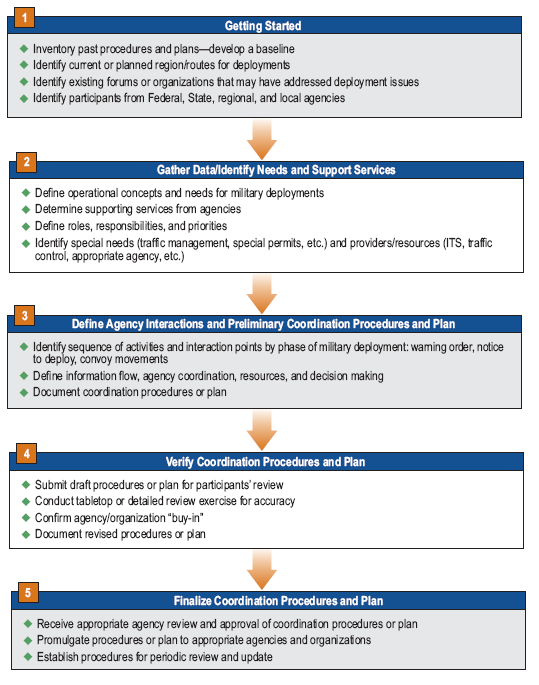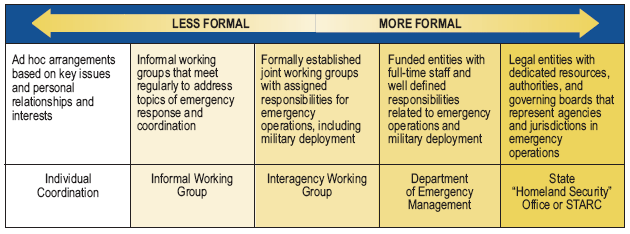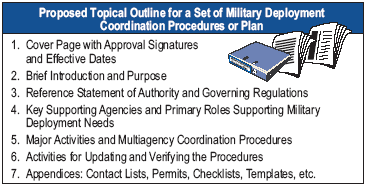Coordinating Military Deployments on Roads and Highways:
A Guide for State and Local Agencies
This publication is an archived publication and may contain dated technical, contact, and link information.
Chapter 4. Recommended Coordination Procedures
A series of coordinated activities is triggered the moment the military receives a warning order and ends when convoys arrive at their destination. Some of these activities require support from various State agencies to efficiently and safely assist the military move to its destination. This chapter describes a five-step process for developing or refining coordination procedures or plans. The elements of the procedures or plans are built on the roles and responsibilities of key agencies described in chapter 2 as well as a detailed understanding of military deployment planning and movements on public roads described in chapter 3. This process is in use as is but can be adjusted to meet local needs.
Developing Coordination Procedures
Developing a plan or a set of coordination procedures requires combining the knowledge, expertise, and information of many agencies across several jurisdictions that support military deployments during national emergencies. Effective procedures will result in:
- Well-developed relationships among key agencies and jurisdictions.
- A shared vision among operators and service providers for military deployment activities.
- A means of testing and verifying performance.
- Confidence and trust among agencies necessary to support military missions during emergencies.
The focus for users of this guide is on developing procedures or plans that address operational issues or concerns associated with military convoy movements. Procedures are activities and the associated testing/updating steps that an agency performs to meet military deployment needs. A plan is a comprehensive description of activities, resources, roles, and responsibilities with additional detailed consideration for updates and testing. Both approaches are appropriate; they should be chosen based on the needs and requirements of each State or jurisdiction. In either case, the development of a plan or set of succinct procedures will require cross-agency and jurisdictional coordination and collaboration for military convoy movements to be effective. A final plan or set of procedures will address how multiple operators and service providers from different agencies and/or jurisdictions can work together to promote effective military convoy movements.
Action Steps for Developing Coordination Procedures or Plans
Developing a set of coordinated procedures or plans requires several steps. A five-step process is recommended (see Figure 18). First, the Emergency Response Coordinator at the SDOT should develop an inventory and an understanding of current procedures or plans, identify the organizational structure or format for developing the procedures, and identify key participants or agencies. The second step is to gather data and assess deployment needs and supporting services from State/local agencies; third, document an initial set of coordination procedures and actions based on the typical sequence of deployment activities, interactions, and coordination points; fourth, verify the plan through detailed reviews or exercises; fifth, finalize and approve the plan. The Emergency Response Coordinator should then distribute the coordination procedures or plan with a proposed approach for further testing and updates.

Figure 18. A Recommended Five-Step Process for Developing Coordination Procedures or Plans
Step 1—Getting Started
The Emergency Response Coordinator at the SDOT should verify the existence of current procedures and plans for supporting military deployments; this information will provide insight into the scope and scale of the update required or the creation of new procedures if necessary. The current procedures may be part of an existing EHTR or may be a set of independent coordination procedures and plans.
A review of documents will highlight the current and proposed routes on which military deployment coordination is needed. This information is usually available from the DMC. The magnitude of any discrepancies or differences between current procedures and needs should be noted for later review and consideration. Additional data may need to be collected from others to gather sufficient background information about military deployment routes, current permitting processes, contact lists, communication practices (technical and organizational), and recent validation of the current procedures or plan. This may include discussion and coordination between headquarters and district/regional offices of several State agencies.
Once this preliminary inventory and understanding has been developed, a process for developing or refining a plan or set of procedures can be selected using one of several approaches. One approach involves ad hoc work groups formed on a regular basis to define and address deployment procedures. At the other extreme, a formal planning body or group may address military deployment coordination and activities. Such formal bodies may exist in some States and reside in agencies with responsibility for statewide emergency management or homeland security functions. Figure 19 illustrates the range of organizational structures available. In any case, a determination must be made as to the type of planning approach and the use of formal or informal organizational structures.

Figure 19. A Range of Organizational Structures May Be Used by States to Develop Coordination Procedures or Plan
In addition to determining the organizational structure and means for developing the procedures or plan, the appropriate participants must be identified, including, at a minimum, the six key agencies identified in chapter 2 (i.e., the SDOT, SDPS, State emergency management representative, State DMC, military installation representative, and commercial seaport representatives). Coordination between headquarters and district/regional offices should be handled by each agency and should include coordination with local agencies such as law enforcement, departments of public works, and emergency coordinators.
As a result of this first step, the SDOT Emergency Response Coordinator will have a baseline description of existing procedures, basic military deployment needs, organizational mechanisms for subsequent discussions and coordination across agencies, and identification of key individuals and/or agencies (Figure 20).

Figure 20. Summary Checklist for Step 1—Getting Started
Step 2—Gather Data/Identify Needs and Support Services
The DMC will be one of the best sources for identifying operational needs for a military deployment. This individual works closely with the deploying military installation to identify needs, establish and track the timing of major activities, coordinate with other DMCs as needed, and act as the primary interface with other State agencies. Because of the past working relationship among State agencies, military needs should be relatively routine and well defined. However, depending on the military mission, special needs may also be highlighted, such as unusual time-of-day movement needs, use of special vehicles, unconventional convoy operations or sizing, use of alternative or restricted routes different from the standard routes, and enhanced force protection and convoy monitoring. Special needs or the volume of convoy movements may require additional agency resources or other agencies/organization may need to be informed. For example, for substantial convoy movements planned through a metropolitan area, traffic operation centers may need to be alerted about the timing and volume on the convoy routes. These deployment needs and supporting agency services should be identified because they may affect staffing and workload assignments.
Supporting agencies also must reconfirm their roles and responsibilities. Chapter 2 highlighted the major functions and roles—these must be confirmed among the supporting agencies and participants to ensure proper allocation of responsibilities and resources. In step three, these roles and responsibilities will be further refined during detailed discussions of activities, information flow, agency coordination, and decision making.
Agency representatives should discuss their general preparedness to support military deployments. Such activities include:
- Updating point-of-contact lists with 24-hour accessibility to authorized decision makers.
- Establishing interagency communication systems.
- Providing for public safety and public information needs.
- Identifying points of contact at regional and/or district offices as well as emergency and transportation operations centers.
- Confirming the ability to access key information about approved convoy movements such as existing permits, current and accurate roadway conditions, special needs, and other information.
Consideration should also be given to incident management events, HAZMAT needs, rapid procurement procedures, and agency authorities/regulations. This can help on-site and supporting personnel become aware of their responsibilities and interagency agreements during convoy movements. The intent is to build an understanding of major responsibilities and a trusting relationship among agencies prior to the need for any special multiagency response during convoy movements (Figure 21).

Figure 21. Summary Checklist for Step 2—Identify Needs and Support Services
Step 3—Define Agency Interactions and Preliminary Coordination Procedures and Plan
As a result of steps 1 and 2, background information and lists of military and support agency needs have been identified. These needs should be matched to the typical phases of a military deployment, namely the issuance of a warning order, followed by the notice to deploy, and the actual convoy movements. In certain States, some of these phases may be combined. This alignment of needs will provide the basis for identifying agency activities and documenting a plan or a set of coordination procedures.
Based on the needs, agency representatives should describe a concept of operations—those activities the supporting agency will perform to meet those needs. Sometimes the activities will require the identification of resources and/or actions only from a single agency (for example, SDOT will issue a permit). Other times, multiple agencies will need to coordinate their actions, indicating such attributes as primary or secondary roles, points of contact, resource/information needs, and others. In the case of the SDOT, the following set of steps is typically required:
- Inventory of existing highway conditions based on the proposed routes and military needs—work zones, construction locations, weight restrictions, operational chokepoints, etc.
- Confirmation of selected routes (and possibly alternative routes) for convoy movements.
- Assessment of traffic operations and/or traffic management needs to ensure effective convoy movements and minimal disruption to civilian traffic.
- Issuance of permits, priority permits, movement authorizations, and/or special permits for military and commercial haulers.
- Preparation for special needs or circumstances such as rest areas, time-of-day restrictions, etc.
- Monitoring of convoy movements and response to special needs of convoys-in-route (TOCs, road patrols, etc.).
- Assessment of interagency coordination and areas for improvement.
- Verification of communication protocols and interoperability.
Once the sequence of activities by the military and support agencies has been delineated, key interaction and interface points can be identified. These interaction points help to further define the required information flow between and among agencies. Some activities may involve multiple agencies. For example, once a notice to deploy has been received, public affairs officers in all supporting agencies should be made aware of the impending convoy movements. This information will usually be "For Information Only" types of exchanges, but will provide valuable contact information if unusual circumstances or inquiries occur during the convoy movement phase. Similarly, interagency communications procedures and protocols during normal and emergency situations should be confirmed.
Once the entire sequence and key interaction points have been defined and confirmed, a comprehensive review of the plan or set of coordination procedures should be made. This review step will ensure all the detailed activities have been identified and properly sequenced, the appropriate supporting agencies are identified, and agency representatives are aware of their supporting roles and responsibilities. The following topical outline of a set of coordination procedures or plan is offered as a means of organizing and documenting the products from this step (Figure 22).

Figure 22. Proposed Topical Outline for a Set of Military Deployment Coordination Procedures
Section 5 (Major Activities and Multiagency Coordination Procedures) of the proposed outline should contain many of the detailed steps, definition of lead/support agency responsibility, and responses to the checklist items identified in chapter 3. The level of detail is best illustrated through the following example.
During a convoy movement on a preferred route, a regional Traffic Management Center (TMC) is aware of the convoy movement, types/volume of vehicles, and preferred route. The TMC operators monitor the traffic conditions within their traffic networks and provide periodic updates via telephone to the DMC, if required and requested by the DMC (subject to workload and availability at the TMC). If field sensors of the TMC indicate a change in traffic flow along a designated convoy route, the TMC operators may choose to observe the possible causes of the delay through closed circuit TV (CCTV). If the delay is increasing and is above a threshold value of importance to the DMC (for example, the delay is expected to be greater than 20 percent of the average travel time through the affected corridor), the TMC operator would contact the DMC via telephone to warn of potential convoy travel delays. The TMC operator would provide additional information (as available) about the cause of the delay (incident, estimated time-to-clear, identification of lane closures, and/or other causes). This information would allow the DMC to make a decision on the need to reroute the convoy to meet destination orders and requirements.
Similar levels of detail would be needed for other coordination and interaction points of the plan or set of coordination procedures. Coordination and interaction points for traffic management and operations include such items as:
- Interoperability of communication systems (800 MHz, 900 MHz, bridge circuits, common dispatch centers, etc.).
- Selected ramp metering controls to maintain desirable freeway speed and facilitate time convoy movements.
- Public information notice via highway advisory radio (HAR) broadcasts.
- Use of special event signal timing plans to coordinate convoy movement.
- Special use of service patrols to monitor convoy operations.
- Increased visibility of convoy movements from the DMC to assist traffic engineers/operators in monitoring and controlling traffic operations and military coordination (automatic vehicle location [AVL], in-transit visibility [ITV]) technologies that require interoperability).
- Use of variable message signs to maintain or improve traffic operations during deployments (e.g., "Convoys in Center Lanes").
- Prepositioning of critical assets (tow vehicles and service vehicles, for example) or service patrols in potentially vulnerable segments of the highway network.
- Coordination of citizen cellular phone traffic information among SDPS and SDOT operators.
- Hand-off procedures among local, State, and regional TMCs.
Ultimately, the coordinating agencies should assess the appropriate level of detail and document this detail in the plan or procedures (Figure 23).

Figure 23. Summary Checklist for Step 3—Define Agency Interaction and Preliminary Procedures or Plan
Step 4—Verify Coordination Procedures and Plan
Once a plan or set of preliminary coordination procedures has been developed, it should be submitted for independent agency review and confirmation. This step will ensure the proposed procedures are complete and properly sequenced, and the key coordination and interaction points have been identified. This independent review will serve as a check for internal agency coordination procedures and that all of the key offices or departments have or can provide the necessary information or decisions to support the preparedness and actual convoy movements.
Several approaches exist for the independent review. One is to have an unbiased review team—composed of supporting agency representatives—review the document as if they were required to implement the action steps. This "role playing" approach allows for a limited group of individuals to simulate and highlight areas for improvement. Another approach is to conduct a tabletop exercise with several representatives from the military installation and supporting agencies. This format would simulate the deployment process, including the use of specialized scenarios to test the robustness and completeness of the coordination procedures. Still another approach might include one or two experts offering detailed review and comment.
The review procedures will vary from State to State, but the outcomes should be the same. Based on the independent review, a revised plan or set of coordination procedures should be developed and documented. These procedures should be sufficiently detailed and complete to allow all supporting agencies to "buy in" or formally endorse the approach, as evidenced through an interagency memorandum, cover page signatures from agency representatives, or similar method.
Step 5—Finalize Coordination Procedures and Plan
Once the preliminary coordination procedures have been reviewed and revised, the final set of coordination procedures or plan should be documented. The documentation should include activities for keeping the plan current through reviews and updates at least annually. Specialized cross-agency training may be necessary using the coordination procedures as a guide. Once completed, the documented plan or procedures should be submitted for formal approval (signature) and distribution to the supporting agencies. Some agencies include the coordination procedures as part of statewide emergency transportation management procedures.